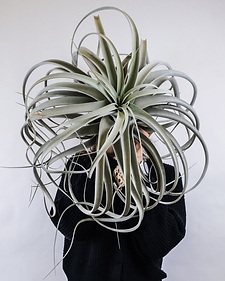It’s all the fad… those tiny spidery looking plants that seem to grow out of thin air called air plants. Air plants, otherwise known as Tillandsia in the family Bromeliaceae, are epiphytes. Epiphytes are plants that grow on objects for support only, not nutrients. Tillandsia plants are relatively easy to care for and can be displayed in unlimited and unique ways. You’re only limited by your imagination. Read on to understand how to take care of air plants indoors.
(Some of the links within this post are affiliate links on which I receive a small compensation from the sale of certain items.)
(As an Amazon Associate I earn from qualifying purchases.)
Facts About Air Plants
Air plants can be purchased almost anywhere these days, from nurseries, to big box stores, to supermarkets. Before you purchase one, here are some general tips and facts regarding Tillandsias.
1. They are epiphytes meaning they attach themselves to objects, mostly tree limbs in the wild.
2. Air plants are native to the mountains and rain forests of Mexico, Central and Southern America, and the West Indies.
3. They grow in a rosette pattern and will produce flowers from the center.
4. Generally they have either silver or green foliage. The silver foliage variety looks fuzzy and is more drought tolerant, whereas the greener variety (flat leaves) will dry out more quickly and need more frequent waterings.
5. Tillandisias are easy to display in glass globes, terrariums, or attached to driftwood or macrame.
6. Their roots are small and are only used to attach themselves to objects.
7. Air plant leaves have trichomes which are small hairs that help absorb water and nutrients from the air and moderate their temperature.
8. Do not think air plants are your typical house plants. They do not require the same care as house plants.
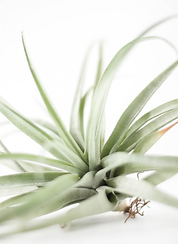
9. Some popular air plants are:
-
Ionantha.
-
Stricta.
-
Brachycaulos.
-
Aeranthos.
-
Capitata.
-
Caput Medusae.
-
Streptophylla Hybrid.
-
Tectorum Ecuador.
Care of Air Plants Indoors
Air plants are easy to care for. Follow these general rules.
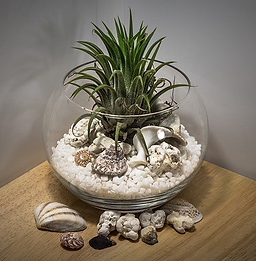
1. Frequent misting every other day and submersion into water 20 to 30 minutes every other week should sufficiently water your plant if your home is not too dry.
2. Place them in an area where they receive indirect filtered sunlight, not in direct sunlight.
3. Do not plant them in soil.
4. Fertilize your air plant every quarter of the year with a specific fertilizer for Bromeliads, (family of air plants), or an indoor water soluble houseplant fertilizer from Amazon. If using an indoor fertilizer for house plants, use 1/4 of the recommended amount in your mister.
Air Plants in Glass Globes and Terrariums
Displaying an air plant in a glass globe adds beauty to your collection of indoor plants.
Once you have purchased your air plant, (Ionantha Guatemala grows well in globes), submerge it in a sink full of water for 30 minutes to guarantee it has been properly watered. Take note of how the plant looks now that it has been plumped with water. This is the way you want your plant to look at all times. Remember this when deciding when to water your plant.
Remove the plant from the water, gently shake it out, and place it upside down in a dish rack on a paper towel to thoroughly dry. Standing water on the leaves or roots will cause the plant to die.
Once the plant is almost dry, either place the tillandsia in an empty globe or on sand or pebbles as a display inside your globe.
Be sure to adequately space the plants to enhance air circulation if you are planting more than one in the same globe.
If your globe is small, only mist it every 4 to 5 days because the water will not evaporate as quickly. If the globe is larger, mist it every 2 to 3 days. A larger open globe will require misting more frequently.
Place your globe out of direct sunlight but in a bright sunlit room.
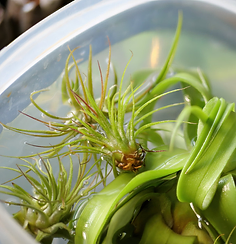
Type of Water to Use on an Air Plant
As stated by “savvygardening.com”, you must be careful with the type of water you use for your air plant.
Do not use softened water. The salt will build up on the plant leaves.
Do not use distilled water.
Use tap water, but let it sit out for 24 hours to ensure that the chlorine dissipates.
Another alternative is pond water or aquarium water. Do not fertilize the plant if you are using this type of water.
Good Air Circulation
Allow for proper air circulation between the plants in a globe or if they are attached to other objects. You do not want the plants to rot due to too much moisture.
Sunlight
Place your plant in indirect bright sunlight. Remember, they are native to forests and grow on limbs of trees that are protected by the canopy of leaves.
Artificial Light
If you do not have proper lighting in your home, use artificial full spectrum lighting. Keep the plant 6 to 36 inches from the light tubes and set the timer for 12 hours.
Temperature
Tillandsia are native to warmer climates. Do not place them in an area that dips below 40 degrees F, (4.4 C), because they will die.
A warm, humid location away from drafts will supply a good climate for air plants.
Ideas for Mounting or Attaching Air Plants
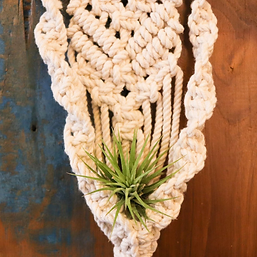
Air plants can be mounted or placed onto almost anything except a moist object that retains water.
Some suggestions include macrame hangings, driftwood, rocks, shells, tea cups, bark, wreaths, frames… the sky’s the limit!
Wire
Mount them using their roots and bottom leaves with florist wire. Do not use copper wire because it will kill the plant. You can purchase florist wire at any large box store.
If you use wire, do not use too much. You want to easily remove it and soak the plant every 2 to 3 weeks or as needed.
Fishing Line
Since fishing line is clear and is easily hidden. Gently weave it through the leaves and roots to attach the plant to wreaths or perhaps to hang it from the ceiling!
Roots
This is a permanent attachment. The only purpose of a tillandsias roots is to attach the plant to objects. If you want to attach it to a piece of bark or driftwood you can use wire and wrap it around the roots and leaves and then attach the plant to the object. It will take some time for the plant to attach to the object on its own, so be patient.
Glue
This technique is also a permanent attachment. If you are using glue to adhere the plant to an object, use the proper glue. W6000 air plant glue is a good choice since it is waterproof and will not harm the plant. Add a little dab onto the bottom of your plant, not the leaves, and attach it to the object.

Remember, the plant does not do well in objects that absorb water like bark and driftwood. You can still mount them onto this type of object but you will need to water them by dipping them into a basin of water rather than soaking them. An air plant will rot if it is sitting on a moist object.
Caring for Air Plants Indoors – It’s Not Difficult
Air plants are an easy and unique way to bring nature indoors. Given the proper moisture in the form of misting and water through submersion, sunlight, air exposure and proper placement onto an object that does not absorb water, your plant should grow for years. Tune in to my next post on the life cycle of air plants.
I hope you have enjoyed this post and learned a lot about air plants. Please leave a comment below and share it with others.
Happy Gardening!
Nina

